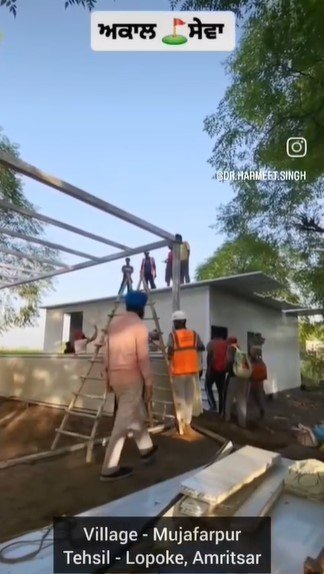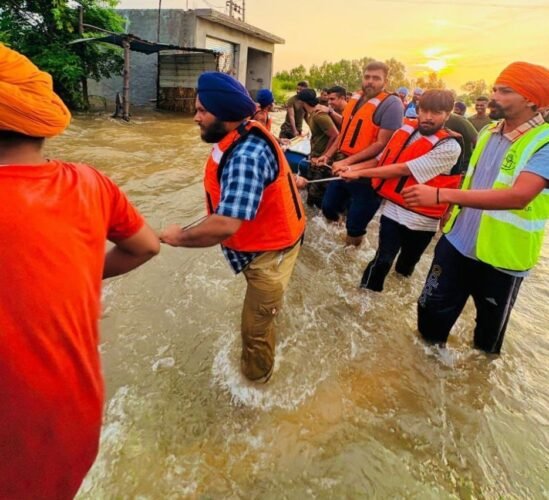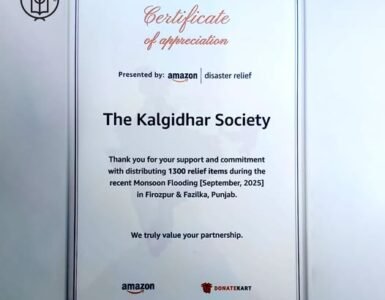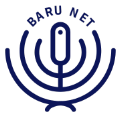The Story- How we (The Kalgidhar Trust) stepped forward in Punjab’s hour of need – and also earned recognition for doing more than relief work
Nature unleased it’s fury, and the extremely devastating floods in Punjab in August 2025 submerged over 2,200 villages and destroyed more than 2.2 million acres of farmland.
This is the story of what was done, how it was done, and what lies ahead -— not for recognition, but as a record of service and inspiration for all who believe in “Sewa.” ( The spirit of Selfless Service)
The work has not ended; it is ongoing and will continue for months until life in the society starts taking shape again.
Recognition of the work was earned too, See the article in the Business UpTurn
In this crisis, the Business Upturn article “Rebuilding More Than Walls” acknowledges the scale, urgency, and humanity of the response , and places Kalgidhar Society as one of the major NGO’s in the relief and rehabilitation efforts.
When the Water Rose, We Responded Quickly
Mobilising Existing Infrastructure
One of the strengths Kalgidhar brought to the table was deep roots in rural Punjab, with over 130 schools (Akal Academies) across the state, and with the community trust and infrastructure already in place. Within days of the deluge, Many of the Akal Academies were converted into relief camps.
“And these weren’t basic shelters. They became multipurpose lifelines—warehouses for rations, kitchens for langar, clinics for the sick, even workshops where villagers repaired flood-damaged equipment.” – Business Upturn
These Multipurpose stations were improvised as:
- Warehouses to store relief materials, and distribute them from there
- Kitchens (langar) feeding hundreds or thousands daily
- Medical camps for first aid and preventive care
- Workshops where villagers repaired tools, appliances, or equipment damaged in the floods
- Communication and Help Centres as focal node points
This approach meant relief was not fragmented but organized so that people found multiple services under one roof, reducing the burden of movement and coordination.
Partnerships & Coordination
We did not act alone. Close coordination with National Disaster Response Force (NDRF), District Commissioners, and Sub-Divisional Magistrates allowed us to:
- Deploy powered boats into submerged areas
- Use JCBs and earth-moving machinery to clear debris or create temporary embankments
- Synchronise relief supply chains to avoid duplication
“Thousands of volunteers joined—teachers, students, local residents. Langar kitchens cooked around the clock. Medical teams moved from village to village, treating injuries, vaccinating children, and distributing medicines to stop outbreaks of cholera and typhoid.” – Business Upturn
The Quiet, Crucial Work After the Deluge
Once waters receded, the dirty, dangerous, invisible challenges emerged:
- Draining stagnant water to prevent vector breeding
- Disposing of carcasses (cattle, buffalo, goats) using lime and salt to avoid disease
- Disinfection of village zones to guard against cholera, typhoid, and other epidemics
These tasks rarely make headlines. But they save lives. Kalgidhar’s teams took them on courage and the spirit of Sewa, in the physically grueling or demoralising settings.
It was work born of necessity, humility, and the belief that when immediate rescue ends, service must continue.
Rehabilitation- Rebuilding Hope

Prefabricated Homes – Building Dignity
Rather than tents or shanties, Kalgidhar launched a prefabricated housing model: one- and two-bedroom designs, with kitchen, toilet, and verandah. These homes are not temporary stopgaps — they are real, functional houses, giving displaced families a place they could call “new home.”
For families whose brick-and-mortar houses were washed away, these homes were psychologically meaningful — part of restoring a sense of normalcy and stability.
#Akal-Relief-Homes
Leveraging Corporate & Community Support
Relief and rehabilitation at this scale require resources. We are grateful to corporate partners — Amazon, Infosys, Nestlé, Sigma Corporation, Indus Valley, Donatekart, The Better India which came forward to support materials, logistics, funding, and manpower. Partnering is the way to work for the best benefit of society. Also besides sharing of funds, resouorces and work, these partnerships symbolise the trust and belief that when a community suffers, institutions and society must step forward.
Lessons, Challenges, and The Road Ahead
As Rehabilitation work continues, Kalgidhar’s plan includes:
- Rebuilding connectivity (roads, small bridges)
- Restoring livelihoods (agriculture support, seed distribution, small grants to farmers)
- Psychosocial support (especially for children, women, elderly traumatized by the floods)
- Education to the kids – This is a forte of the Trust;and the people in the rural communities have been dependant on th Akal Academies for cheap or free quality education for decades
- Long-term disaster resilience training (flood-aware construction, drainage planning)
- The goal: by the time the next monsoon arrives, the communities are stronger, more prepared, and less vulnerable.
The Challenges remain but will be solved
- Logistical bottlenecks in remote or deeply submerged zones
- Scaling prefabricated housing beyond initial phases
- Build disaster-ready infrastructure (better drainage, elevated roads, flood barriers)
- Ensuring sustainability of livelihood restoration
- Dealing with emotional, psychological toll on staff and affected people
- Scale up livelihood support programs
- Preparation for the future -Engage local youth and women in disaster-resilience training
A Note of Gratitude & Appeal
To all our volunteers, staff, beneficiaries, corporate partners, government agencies, local communities – This work is not ours alone. It is collective. The recognition in Business Upturn is a testament to what can happen when many hands come together in service.
We remain committed to rebuilding lives, restoring dignity, and strengthening resilience. In Punjab’s darkest moments, the collective spirit has shone through.
As we reconstruct, our hope is to leave communities not just whole, but stronger.
Together, we will rebuild Punjab.
Also see – More from the news
#Akal-Relief-Homes
















Add comment